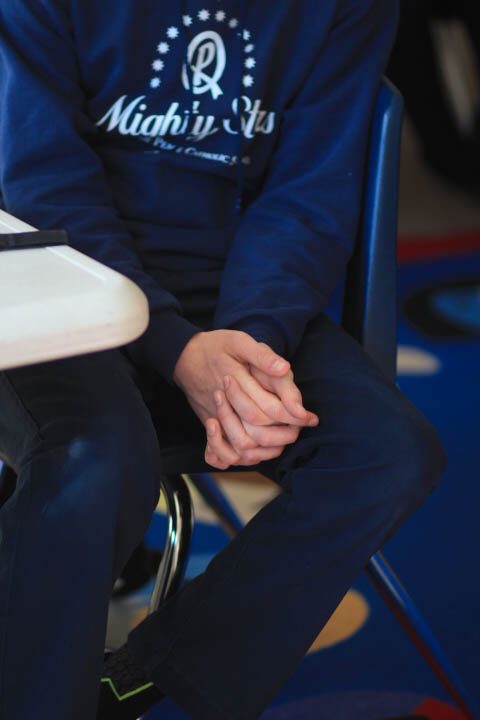
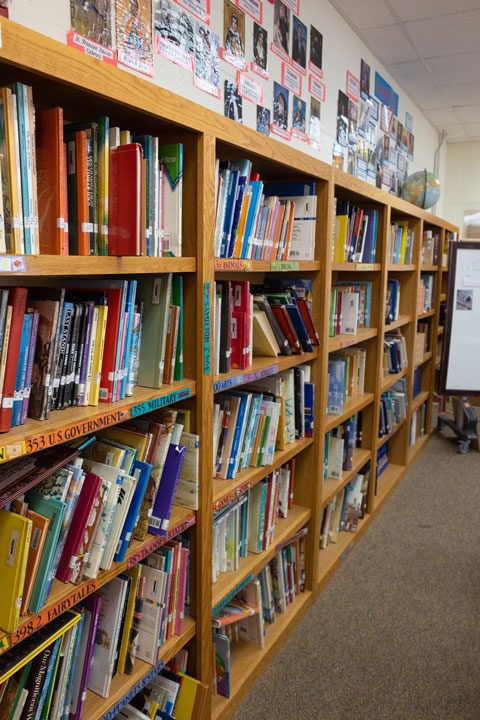
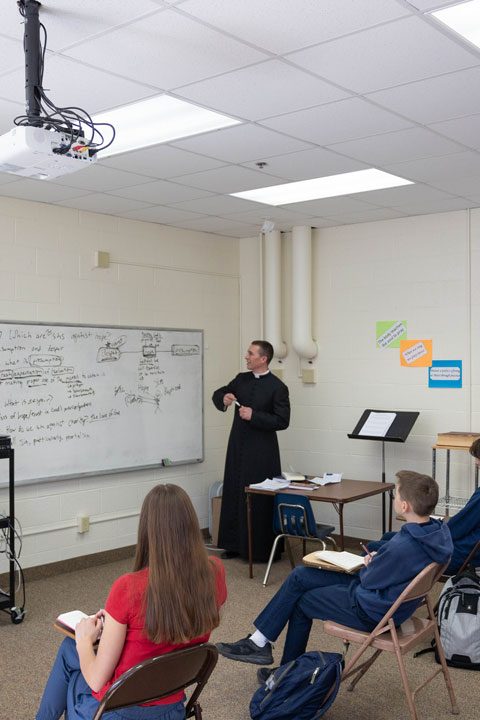
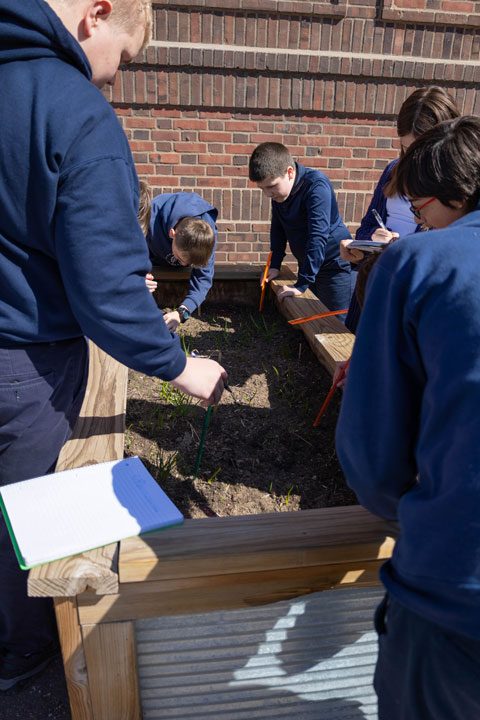
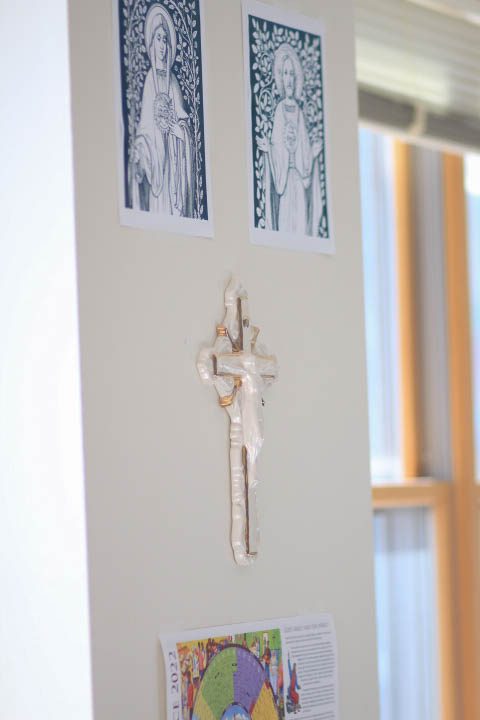
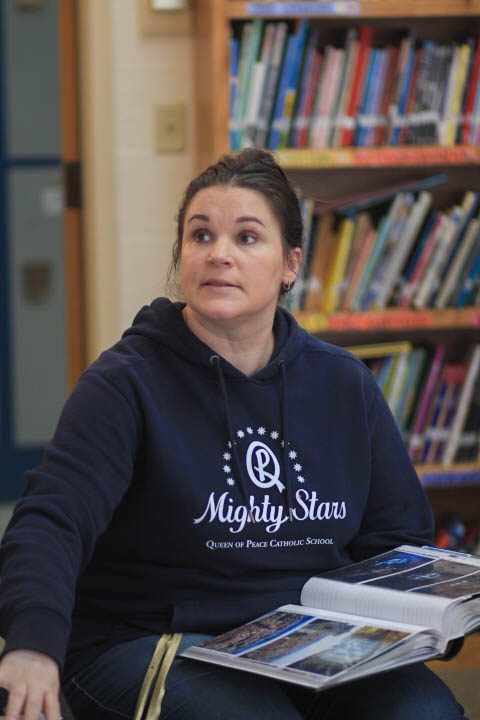
Middle School 5th-8th Grade
Our great educational heritage is not the same as the ultimately experimental education models that one finds in most schools today, where the hand of God is ignored or denied. Based in true openness of mind and heart, the schools of our tradition are better, for the plain reason that they acknowledge and are built upon better foundations.
Our teaching philosophy at Queen of Peace is inspired by the first three liberal arts: Grammar, Logic, and Rhetoric. The liberal arts were identified within the Catholic tradition centuries ago, for being those arts that prepare a person to live a free and accomplished life. Together, the first three liberal arts are called the Trivium.
The common practice of classical programs like ours is to view the arts of the Trivium as three-stages, like levels, by which students can ascend to mastery of any subject area. Take grammar to broadly mean building block knowledge; take logic to broadly mean knowledge of proper relationships, functions, and contexts; take rhetoric to broadly mean the masterful direction of these two prior arts for increasingly useful and personal purposes. It is easy to see how the skills required for each of these successive arts correspond to the natural skills that children develop as they mature. Teaching with a grammatical emphasis actually serves students’ natural inclinations in grades 1-4, when they are at an age of collecting names and ideas and compiling foundational understandings. Teaching with a logical emphasis actually serves students’ developing inclinations in grades 5-8, when they are becoming capable of deeper understandings, but need support identifying and navigating the virtues and justice of things. We do not teach high school at Queen of Peace, of course, but we prepare students for experiences in grades 9-12 that will emphasize the art of applied subject-area knowledge in increasingly masterful and dignified ways.
*** For the past few years, the Mater Dei Apostolate, in Duluth, has been the Catholic high school option that has clearly taken up the mantle of the Trivium where our Queen of Peace program leaves off. Years 9-12 at Mater Dei are consciously designed with the Rhetoric focus that the QPCS grades 1-4 Grammar and grades 5-8 Logic emphases build toward. This year, the diocese will open a new high school program at Stella Maris as well. Stella Maris uses a classical liberal arts approach that is also in keeping with the Trivium approach used at Queen of Peace.***
Middle School 5th-8th
At Queen of Peace Catholic School, we call the deeper understandings of each subject area the LOGIC of that subject. We consider grades 5-8 our Logic grades, when we focus on building the skills that put foundational knowledge to use: teaching where things come from, how things happen, why they work, and what it means for our lives as men and women who live within the encompassing justice of Divine Love.
THE CURRICULUM
The Middle School Curriculum is delivered through seven regular classes – Humanities, Math, Science, Spanish, Schola Cantorum (liturgical choir), Catechism, and Physical Education.
Once a week, on Fridays, the students have a volunteer-led enrichment class, presented by a member of the parish community. The content of the enrichments varies, reflecting the special skills of the parishioner community members who are volunteering to teach the class or series of Friday classes (the 2020-2021 school year saw students guided through the arts of baking, butchering, canoeing, volleyball playing, computer programming, rosary braiding, and more).
Diocese of Duluth Standards
Queen of Peace Catholic School is a standards-based academic program, in which teachers build some of their own curricula to meet the Curriculum Outcomes for the Diocese of Duluth (https://www.dioceseduluth.org/). The Diocese of Duluth curriculum standards meet and exceed the content standards of the State of Minnesota in all core subject areas.
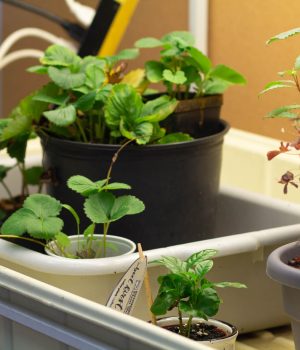
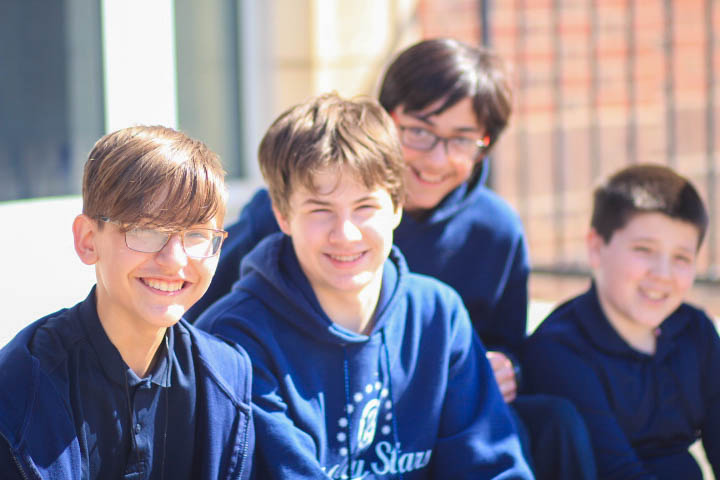
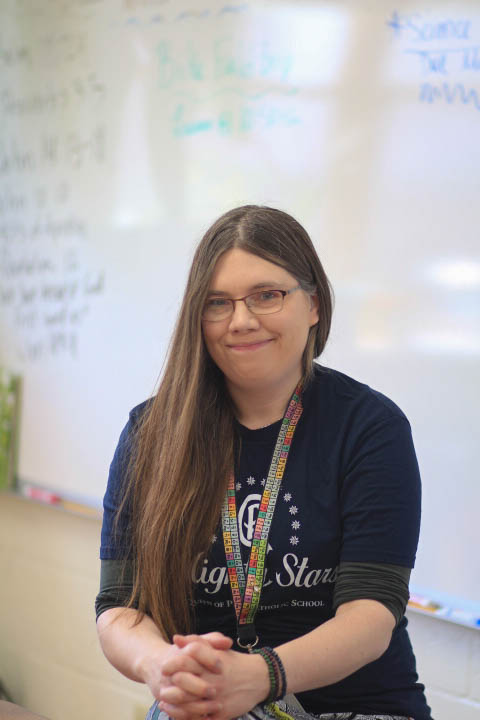
The Queen of Peace middle school program includes:
Daily MassDaily prayerCatechismEnglish language artsCivics and Virtues |
MathematicsNatural SciencesHistoryGeographySchola Cantorum (liturgical choir) |
ArtSpanishPhysical educationNutritional educationSafe Environment education |
Humanities
Middle school students spend the most time each day in their Humanities class block (105 minutes). Literature holds pride of place in our Humanities curriculum: an interdisciplinary program that combines English, History, Civics, Geography, and Art. The Humanities block is meant to remind students of the homeroom structure they are familiar with from elementary years, but it is shorter, because now the teaching of Math, Science, and Catechism has been broken out into separate classes.
Our classroom literature enriches our students’ vision for themselves, as we explore the virtues embodied in the great characters, epics, folktales, poems, prose, and histories of the Catholic, English-language, and American traditions: from King David King Arthur to Paul Revere’s ride and The Song of Hiawatha, from Charles Dickens and J.R.R.Tolkein to G.K.Chesterton, J.M.Barrie, and George Orwell. In selecting books for classroom reading, we do use award-winning modern stories, but we give special emphasis to authors and works that multiple generations have held up as worthy of praise and preservation – i.e., The Great Books.
Wherever feasible, our Humanities teacher uses literary texts in her English units that match the epoch being studied in the class’s history units. This plan for thoughtful continuity across units uses the Great Books to bring the other academic disciplines to life. Alongside class discussion of the civic and personal virtues that make the stories’ characters, attention can be drawn to the facts of history that are germane in the life and problems of our heroes and to how geographical trivia have relevance for our stories’ plots and settings.
Name-Brand Curricular Resources
Beside their customized curricula, our teachers also achieve the diocesan standards using textbooks and prefabricated curricula. For 2021-2022, the textbooks/prefabricated curricula used in the middle school program include:
Language Arts
We use the Voyages in English curriculum. In the words of the publisher, Loyola Press, this “robust grammar and writing program has helped teachers meet the individual needs of each of their students for more than 70 years. With rigorous instruction, advanced teacher support, and engaging exercises, this K–8 program presents challenging concepts in a balanced approach that empowers students to become the critical thinkers and effective communicators of tomorrow. Voyages in English is aligned with the Common Core State Standards and correlated to the National Council of Teachers of English Standards.”
Math
Most of our students complete their PreK-5 Dimensions series Singapore Math program (published by Singapore Math Inc.) in years 5, 6, and 7 of middle school. In an industry where “new and improved” curricula come out every year, Singapore math is one of the few that has actually driven higher achievement results across real large-scale student populations, worldwide. This curriculum teaches children the “how and why” of foundational math, steadily building skills with the goal of preparing them for more advanced topics. Singapore math is about drawing connections, supporting the thinking process, and instilling thorough mathematical understandings. It encourages perseverance and naturally gives confidence as we become equipped to solve problems using many different tools.
Our students commence using the An Incremental Development Saxon Math program (Hake/Saxon) in grade 8. According to Seton Educational Media, Saxon’s “unique incremental development with continual practice and review approach to math instruction provides a most effective method for preparing a student for the SAT or ACT. The entire Saxon program positively reinforces the fundamentals and enables all aspiring young adults to achieve and excel in mathematics.” In 6th grade, most Queen of Peace students will use the Saxon Math 76 textbook. In 7th grade, most students will use the Saxon Math 87 textbook. In 8th grade, most students will use the Saxon Math Algebra 1 textbook.
Our math block is 50 minutes long and is set at the same time for all classes, K-8th grade. This allows flexibility to group diverse learners according to need and achievement rather than assuming all students will proceed at the same pace, because of their age. We use the NWEA assessments to track achievement needs, and we administer a math placement exam at the beginning of the 2023-2024 school year, to ensure that all students are being supported appropriately in their math progress.
History
We use Susan Wise Bauer’s award-winning Story of the World series, published by Well Trained Mind, to put a historical frame on our social studies content in grades 5-8. The Story of Civilization follows four basic historical epochs: 5th and 6th grades – Ancient Times and The Middle Ages; 7th and 8th grades – Early Modern Times and The Modern Age. This chronological historical frame considers Europe, Asia, Africa, and the Americas, and gives our students a narrative and chrono-logical context in which to understand the social studies content of civics and geography while diving more deeply into the cultures that have existed through time…and especially into those that have done most to build the world we still live in today.
Catechism
We use the Catechism of the Catholic Church, the Youcat youth catechism of the Catholic Church (edited by Cardinal Christoph Schoenborn), and the New American Bible. The middle school Catechism class is taught to grades 5-8 by our Queen of Peace parish pastor.
Science
Our students complete their Nancy Larson Science curriculum in Grade 5. Nancy Larson points out that “Every scientist was once a child.” Her science program combines a rigorous curriculum with hands-on learning to create a challenging program that children love. Science 5 focuses on the interactions of systems on a micro- and macro-scale.
Our students commence with using the FusionScience hybrid textbook-virtual content series (Houghton, Mifflin, Harcourt) in grades 6, 7, and 8. Our science teacher uses these award-winning multi-media lessons to supplement her diocese standards-aligned and heavily project-based science curricula, that move between the smart board, the grow-light cart, and out in our planter boxes outside door #5 at Queen of Peace Catholic School.
Safe Environment/Child Protection
We use the Circle of Grace Circle of Grace curriculum to teach students about personal dignity. Circle of Grace is a Christian safe environment curriculum that helps to form and educate children and youth about the value of positive relationships with God and others. The Circle of Grace curriculum teaches children and youth how to identify and maintain appropriate physical, emotional, spiritual, and sexual boundaries; recognize when boundary violations are about to occur; and demonstrate how to take action when boundaries are threatened or violated.
Virtues/Character Education
We use the Virtues in Practice program, from the Dominican Sisters of Saint Cecelia of Nashville, TN. According to the sisters themselves, “Virtues in Practice is a program for children in grades pre-kindergarten through eight to grow closer to Jesus by imitating His life and virtues. It is set up in such a way that a whole school studies the same virtue each month, to provide a whole-school (and at home, whole-family) focus. The program covers 27 virtues over a three-year cycle, with 81 saints held up as models of the virtues.
Please Contact the School Office directly to learn more about what Queen of Peace has to offer your student during their different ages of education. The School Office number is (218) 879-8516, or email for your convenience:
Principal, Mrs. Melissa Marti – principal@queenofpeaceschool.org
Vice Principal, Mrs. Karin Sabyan – ksabyan@queenofpeaceschool.org
Office Manager, Mrs. Amy Kunze – akunze@queenofpeaceschool.org
ACADEMIC PROGRESS
Throughout the school year, progress is evaluated on an on-going basis through assignments and projects, teacher observation within our small-class settings, subject area testing, and report cards. Achievement is also tracked by three norm-referenced test scores per-annum: the NWEA MAP assessments, given in the fall, in the winter, and in the spring.Communication with parents/guardians is on-going throughout the school year by means of daily communication journals, conduct referrals, mid-term progress reports, phone calls, e-mail, and conferences. The teachers keep parents/guardians informed of progress, achievements, and real or potential problems. If problems occur, the parents/guardians are notified and engaged in the effort to locate a positive solution.

